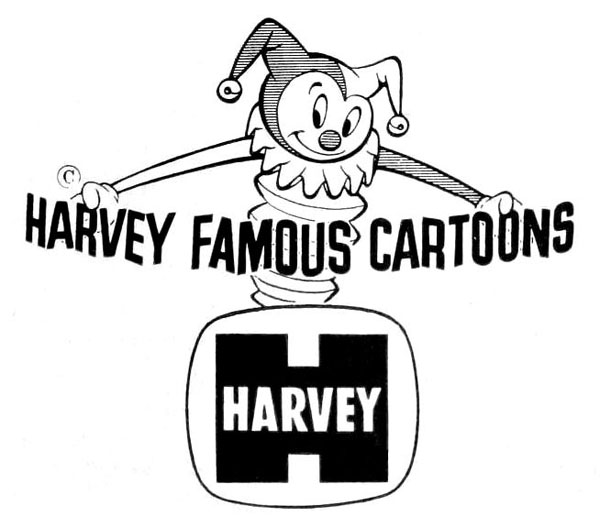
On July 27th 1958 it was made official – Harvey Comics bought the post-1950 Paramount Pictures cartoons, the character copyrights and all merchandising rights. Paramount Pictures retained the theatrical rights to the cartoons (and to this day still house the original negatives in their vaults).
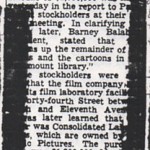
The first public notice of the pending sale of Paramount’s 1950s cartoons to Harvey Comics. From the New York Times, June 4th 1958. Click to enlarge.
Paramount’s in-house cartoon studio, run by Seymour Kneitel, would now continue on – sans its popular original star characters. The 1958-59 season would complete the cartoons contractually obligated to Harvey in the sales agreement – these include subjects in production since 1955 (see the model sheet below for Talking Horse Sense), and left-over Casper and Herman and Katnip entries. Three of the ten “Harvey” character films (including one Baby Huey and one Little Audrey) feature extreme use of stock footage. The other seven suffer from a painful attempt to conform to current limited animation standards – which Kneitel and crew were not used to doing.
Having sold away its well-known properties, the studio began to develop new ones. Starting this season, a new series (Modern Madcaps) would be added – the idea seemed to be that the kid-friendly material would remain in the Noveltoons, and the more adult-skewing material would end up as a Madcap. Note the storyboard (below) for Talking Horse Sense was initially developed as a Noveltoon.
In another move to reduce costs, Paramount signed a three year deal with Eastman Color for printing the cartoon release prints. This began with the final Noveltoon release this year, Out Of This Whirl (which is also the only cartoon in the Harveytoon package – possibly because it was delivered so late – to not have had its original titles altered, retaining its Paramount logo all these years). Paramount would return to Technicolor printing in late 1963.

A pre-sale memo from Alfred Harvey to his brothers indicating that they would fund the purchase of the Paramount cartoons with the sale to a TV distributor. Also note the sketch of an “Aladdin” mascot, probably considered before deciding to update the Noveltoon Jack-In-The-Box.
Below (click to enlarge) a July 17th 1958 memo from Alfred Harvey to his partners about the company policy regarding the Paramount acquisition; and below that, the July 18th official Press Release announcing the sale of the 170 Paramount cartoons by Harvey to the ABC network.
Let’s take a closer look at the Paramount releases of the 1958-59 season.
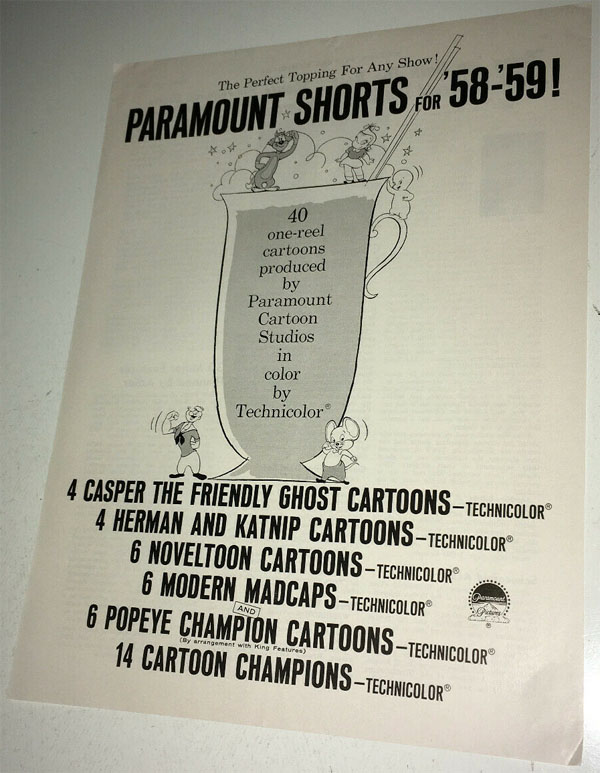


A model sheet from “Stork Raving Mad”
Six (6) Noveltoon Cartoons
STORK RAVING MAD (10/3/58) Kneitel/Tafuri. A baby doesn’t want a stork to deliver him.
DAWG GAWN (12/12/58) (Little Audrey) Kneitel/Johnson. Limited animation really hurts this one. On her way to school, Audrey tries to protect her dog, Pal, from a dog catcher.
THE ANIMAL FAIR (1/30/59) Kneitel. A cheater that compiles animal spot gags from various earlier cartoons such as Fun At The Fair and Philharmaniacs.
HOUNDABOUT (4/10/59) Kneitel/Johnson. Julius the dog decides to be human for a while.
HUEY’S FATHER’S DAY (5/8/59) Kneitel/Johnson. Baby Huey attempts to do all of Papa’s chores for him on Father’s Day.
OUT OF THIS WHIRL (11/13/59) Kneitel/Johnson. A flying saucer lands in a housewife’s backyard and its martian inhabitant (Kosmo) is mistaken for her son. Paramount switches to Eastman color for the next two years; this is the last film delivered for the initial Harveytoon package.
Six (6) Modern Madcap Cartoons
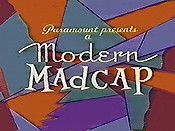 RIGHT OFF THE BAT (11/7/58) Kneitel/Johnson. The “Redskins” baseball scout attempts to add a horse to the team.
RIGHT OFF THE BAT (11/7/58) Kneitel/Johnson. The “Redskins” baseball scout attempts to add a horse to the team.
FIT TO BE TOYED (2/6/59) Kneitel/Johnson. The president of a toy company (voiced by Jackson Beck) is sent to see a psychiatrist (voiced by Gilbert Mack) to find out why he still plays with toys.
LE PETITE PARADE (3/6/59) Kneitel/Johnson. Renoir is tired of parades leaving garbage in from of his house.
SPOOKING OF GHOSTS (6/12/59) Kneitel/Johnson. Mr. McGregor goes to the Wowie Real Estate Company to hire a ghost to haunt his house while he’s on vacation.
TALKING HORSE SENSE (9/11/59) Kneitel/Enders. Oscar Gullible meets Gabby the talking horse.
T.V. FUDDLEHEAD (10/16/59) Kneitel/Johnson. In this rip-off of Gene Deitch’s Terrytoon Topsy TV, Mr. Fuddlehead just can’t stop watching TV.

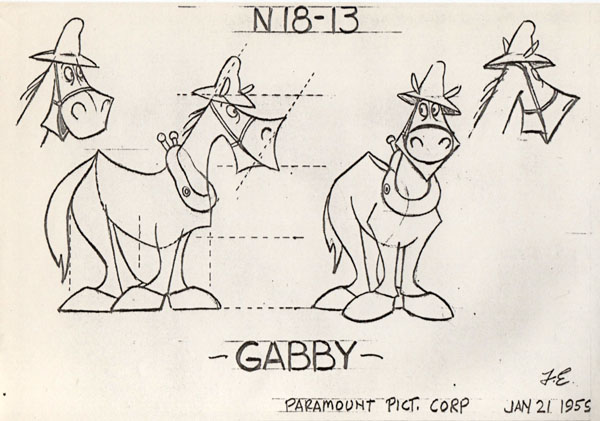
Model Sheet for “Talking Horse Sense”
Four (4) Herman and Katnip Cartoons
OWLY TO BED (1/2/59) Kneitel/Johnson. Herman protects Hooty The Owl from Katnip.
FELINEOUS ASSAULT (2/20/59) Kneitel/Johnson. Katnip teaches little Kitnip how to catch mice.
FUN ON FURLOUGH (4/3/59) Kneitel/Endres. Herman makes Katnip think he’s in the Army again.
KATNIPS’S BIG DAY (10/30/59) Kneitel/Pattengill. Katnip is given a “This Is Your Life” TV tribute which features the final theatrical animation of Herman the Mouse, Buzzy the Crow and “Reuben, Dueben and Louie”, Herman’s nephews. Stock footage from A Bicep Built For Two, Cat-Choo, Mousetro Herman and Drinks On The Mouse.
Four (4) Casper Cartoons

A section of the boards from “Doing What’s Fright”
DOING WHAT’S FRIGHT (1/16/59) Kneitel/Johnson. Casper tries to stop his cousin Spooky from doing his April Fool’s gags.
DOWN TO MIRTH (3/20/59) Kneitel/Tafuri. Casper tries to stop an evil professor who has built an anti-gravity machine.
NOT GHOULTY (6/5/59) Kneitel/Endres. A judge has stripped Casper of his ghostly powers. Stock footage reused from Casper Takes a Bow-Wow and Ghost Of The Town.
CASPER’S BIRTHDAY PARTY (7/32/59) Kneitel/Pattengill. Casper seeks friends to attend his birthday party. Stock footage from too many cartoons to count!
NEXT WEEK: A closer look at La Petite Parade.
(Thanks, Ken Layton)


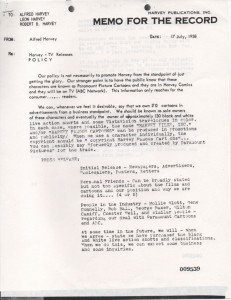
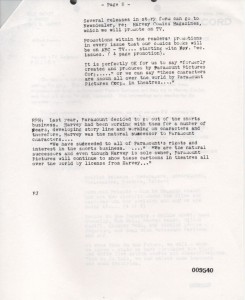


 Jerry Beck is a writer, animation producer, college professor and author of more than 15 books on animation history. He is a former studio exec with Nickelodeon Movies and Disney, and has written for The Hollywood Reporter and Variety. He has curated cartoons for DVD and Blu-ray compilations and has lent his expertise to dozens of bonus documentaries and audio commentaries on such. Beck is currently on the faculty of CalArts in Valencia, UCLA in Westwood and Woodbury University in Burbank – teaching animation history. More about Jerry Beck [
Jerry Beck is a writer, animation producer, college professor and author of more than 15 books on animation history. He is a former studio exec with Nickelodeon Movies and Disney, and has written for The Hollywood Reporter and Variety. He has curated cartoons for DVD and Blu-ray compilations and has lent his expertise to dozens of bonus documentaries and audio commentaries on such. Beck is currently on the faculty of CalArts in Valencia, UCLA in Westwood and Woodbury University in Burbank – teaching animation history. More about Jerry Beck [



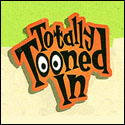



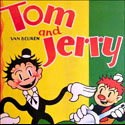
Cartoon Champions reissues for the 1958-59 season:
“Voice of the Turkey”
“Party Smarty”
“The Case of the Cock-Eyed Canary”
“Feast and Furious”
“Starting from Hatch”
“Winner by a Hare”
“Boo-Hoo Baby”
“Casper Comes to Clown”
“Casper Takes a Bow-Wow”
“Ghost of the Town”
“Mice Capades”
“Of Mice and Magic”
“Herman the Catoonist”
“Drinks on the Mouse”
Popeye Champions for 1958-59:
“Quick on the Vigor”
“Riot in Rhythm”
“Farmer and the Belle”
“Vacation with Play”
“Thrill of Fair”
“Alpine for You”
I don’t know how many Paramount cartoons Harvey wound up owning, but I know for certain that the syndication package that ran locally when I was young (in the ’70s) had nothing released after “Out of This Whirl.” No cartoons from the 1960s.
As stated in my text above, Out Of This Whirl was the last cartoon in the initial syndicated Harveytoon package. We shall see in a few weeks why they expanded their purchase of Paramount cartoons (to fill up the network broadcasts of The New Casper Cartoon Show) .
The reason I made the comment was that I’ve heard from people who say that the Harveytoons packages they saw locally as children, in roughly the same time period as I was seeing them, included the post-OUT OF THIS WHIRL Paramount cartoons the company eventually purchased, in addition to the 1950-59 shorts. It interests me that the package I saw never included any of the post-WHIRL cartoons, while other packages apparently did.
Hmmm. According to information emailed to me by a friend of mine, the Harvey cartoons were being distributed in the 1970s by a company named Worldvision. As late as 1975, according to syndication information provided to television stations, Worldvision’s Harveytoons package consisted of 170 cartoons, with “The New Casper Cartoon Show” available separately from the company. By 1976, he tells me that Worldvision had expanded their Harveytoons package to include 244 cartoons and was advertising it as “Casper and His Friends.” Presumably, they simply combined the 170 title Harveytoons package with the cartoons in the “New Casper Cartoon Show” package.
So what cartoons you saw locally just depended on which package your local station had bought and when. Mine obviously had the older bundle with only the 170 cartoons from 1950-59. That explains that.
Jon – Worldvision Enterprises was the TV syndication arm of ABC (as Viacom was for CBS and NBC Films was for NBC). Harvey’s syndication deal with ABC (Worldvision) was for 30 years and expired in July 1988 – just as Jeff Montgomery bought the company from the Harvey family.
Good timing there, I recall a few stations still carrying the Harvey package up to ’87 or so.
Slight correction to the syndication companies. Due to anti-monopoly laws, the TV networks had to sell off their syndication companies.
ABC FILMS was sold to Worldvision (later owned by Taft broadcasting)
CBS FILMS was sold to Viacom (who ironically now owns CBS-TV)
NBC FILMS was sold to NTA (who became Republic TV, who got sold to Spelling Productions, who got sold to Viacom)
I am the big fan of animated cartoons in popular media in TV films comics & animation throughout the world.
I would like more info (or did I miss it) on the “new” Jack-in-the-Box Jester…and his “transformation!”
I notice the Harvey jack-in-the-box has two bells on his cap, while the Noveltoon version had three.
Just like Paramount had to forsake full animation, so to did Harvey forsake any further details on Jack!
Did the last Technicolor cartoons use 3-strip negatives? If not, when did the 3-strip negatives stop?
Also, I have one of the cartoons listed in IB Technicolor 16mm…….
No – the last Technicolor cartoons didn’t have literally 3-strip negatives. Technicolor began using “Successive Exposure” negatives (one roll of film, each frame exposed three times) for animation in the late 1930s.
Technicolor itself stopped its original dye-transfer process in 1974 (in the U.S. – it ended in 1980 in Italy, and in 1990 in China).
The same thing applies to the 1958-59 season as to the one previous with the one-shot efforts and the continuing characters — Paramount’s stories in the late 50s got better as the animation got worse. The quality level isn’t as consistently high here as it was in the previous season, but it’s still a shame they couldn’t have maintained the higher level of animation here, or these cartoons couldn’t have been released when the animation budgets were higher earlier in the decade.
(The ’58-’59 season’s also the one where Winston Sharples borrowed the most heavily from his scores to create his stock music library for TV release. It’s neck-and-neck as to whether the score from “Owly to Bed” or “Huey’s Father’s Day” showed up the most in other New York-made TV cartoons over the next several years.)
Much of the music from the earlier Popeye cartoon “Ancient Fistory” also saw frequent reuse in Sharples’ stock music library,
Don’t forget the “Case of the Cock-Eyed Canary” and “Robin Rodenthood” also had music that became part of Winston Sharples’ stock music package.
Here’s a few more early opnes:
“Rail Rodents”, 1954 with Herman and Katnip and “Fright-Day the Thirteenth”, released on an actual Friday the 13th with Casper.
“Spooking About Africa” and “Child Sockoogy” were two other cartoons earlier in the 1950s that contributed to the stock music catalog. But by the 1959 season, Sharples seemed to be focusing on little stand-alone pieces of music that could specifically fit into a stock music library, while the earlier pieces sound as if they fit in with the surrounding music more seamlessly (“Felineous Assault” from the ’59 season is another short that contributed an often-reused chase music piece to the stock package).
It’s too bad that Los Angeles-based outfits didn’t or coulnd’t use the library, can you just imagine, say, an Augie or Fractured Fairy Tales using a Sharples cue? (Thanks to Ken Layton, I now remember that one Audrey short that used earlier music later in the library-“Case of the Cockeyed Canary”)
Similiarly, of course, on the west coast, the Warner’s Roadrunner “Hook, Line & Stinker” (of the six scored this way before incidental uses in 1963 in otherwise Bill Lava scored shorts and the Bugs Bunny ads on TV) and “Dennis the Menace” (Screen Gems) use of a perky, sprightly chase cue that wound up half-re-composed as the Menace theme was originally written and recorded for Gumby as a open theme, and used in the soundtrck to a few (the credit/open scene “Hook,Line”, Roadrunner music first showed up, at least in episodic music if not as bumper, in the 1956 Gumby “Too Loo”, itself very much like Paramount;s over Noveltoons like so many other early Gumby’s -It’s the Tubby the Tuba like one where Gumby helps some music notes find their way home..this, a la Famous and 1940s Walter Lantz (as Thad Komorowski mentiooned on his blog about Chew Chew Baby–the Lantz, not the controversial Famous one–having future Beany “Cecil Meets Cecilia” background scoring) music, would wind up as stock music, and it was WRITTEN for Gumby 😀
Yes, very good point. Music from 1959 Out of the WHirl was used for MANY Felix (Oriolo) space cartoons, also in the “100000 Dollar Vacation” with Felix, Professor and dog assisant Rockbottom, and Felix’s own dog Sniffer (also, other then recent cues-from 1958’s “Fit to be Toyed”, 1960’s “From Dime to Dime”, 1959’s “Be Mice to Cats” and 1960’s “The Planet Mouse-ola” can also be heard..”:) Go to Vegan Poip Tars channell..P)
So why did Matty’s Funnies switch from showing Harveytoons to Bob Clampett’s Beany and Cecil cartoons?
Ah yes, “Le Petite Parade”… who can forget “Rat-a-ta-ta, Army, rat-a-ta-ta, Navy, rat-a-ta-ta, Le Ministre du Sanitaire! Boom! Feel-thy! Dees-gus-teeng!”
I’m impressed we’re getting a whole post devoted to it next week, a slight departure from continuing with 1959-60 I see.
Guess when the Harveytoons became syndicated to local tv stations that’s when Beany & Cecil replaced the Harveytoons and at around the same time The New Casper Cartoon Show premiered featuring new Casper cartoons and the Modern Madcaps cartoons as well.
I don’t know the proper time frame for this, but one of the voices used in MODERN MADCAP cartoons ended up as part of Fred Ladd’s voice cast to “Americanize” Osamu Tezuka’s ASTRO BOY and KIMBA THE WHITE LION cartoons. I think this individual may be part of the English language translations of GIGANTOR as well.
Kevin, you may be thinking of voice performer Gilbert Mack.
Didn’t Connie Orr do the voice of Walter Wowie’s secretary in “Spooking of Ghosts”?
Corinne Orr had done voice work for Paramount on a few like “Harry Happy” and “Marvin Digs”, I’m sure there’s plenty others I don’t remember at the moment, but I’m sure we’ll get to that soon.
I’ve heard that it was Norma MacMillan who did the secretary’s voice at Walter Wowie’s real estate office in Spooking of Ghosts.
Could be wrong, but have vague memories of “Funday Funnies” being one of the comparatively few network cartoons on Sunday mornings. The opening was modern animation of Harveytoon characters bouncing around a circus setting; was already able to tell Good Old Cartoons from Cheap New Cartoons.
There was also “Cartoonies”, where Paul Winchell and his dummies did bits between shorts. Not sure if that was Harveytoons or Paramount. Perhaps one of the last live-host cartoon shows on network.
For me, the Modern Madcaps were wildly uneven, often little kid cartoons trying to look grownup. One cartoon that stuck with me as a kid had Specs (a little boy who lasted maybe two cartoons) running a space program in his backyard. It had a nice Little Rascals vibe, with the astronaut training and actual rocket looking enticingly attemptable.
I remember Cartoonies pretty well, being a big Paul Winchell fan at the time ( even had a Jerry Mahoney dummy as a kid). Don’t recall seeing any Harveytoons there, mainly Modern Madcaps, some of which later on the Casper show.
Here’s the opening/closing sequences for Matty’s Funday Funnies…
https://www.youtube.com/watch?v=nHi4k2DxucI
http://www.dailymotion.com/video/xv3bd_mattell-sunday-funnies_news
That cartoon you sided was “Cape Kidnaveral”.
The plot of “Dawg Gawn” was recycled for one of Kneitel’s TV Popeyes. (And I think the remake is a better cartoon.)
https://www.youtube.com/watch?v=8Zl6Jf3A9C4
Aside from being the last year of the Herman & Katnip cartoons, this would also be a unusual period as Katnip now sported a pair of pants roughly the same color/look as Herman’s. An obvious call out to the limit animation employed and what seems like a parallel to the bow-tied-wearing animals in Hanna-Barbera’s own TV shows of the day). The only exception is “Herman’s Big Day” which I can only assume was out of consistency with the previous footage shown of Katnip being pants-less anyway. At least that didn’t stick with the comics as the finite look of the character.
We want a totally restored copy of “Dawg Gawn” with the original restored titles, with the original RCA sound digitally mastered, and with the original TECHNICOLOR. Even the “Champions” versions are most interesting to restore many of their original titles with clear sound. And what’s about the “lost” NOVELTOON? There’s a copy in a country… somewhere in the world.
We need to restore completely the Xmas classic, “Santa’s Surprise” from many copies, calibratin’ with all their RCA sound and the original opening and ending titles from Paramount. It’s a totally interesting classic.
“Harvey Comics bought the post-1950 Paramount Pictures cartoons, the character copyrights and all merchandising rights. Paramount Pictures retained the theatrical rights to the cartoons (and to this day still house the original negatives in their vaults). ”
So considering that the Paramount still has the original negatives in their vault does that mean that the original theatrical titles to the Haverytoons cartoons still exist? Or were they swamped out for Haverytoons titles on the negatives bit similar to what happened to films in the UTA package?
Paramount has the original negatives with ALL the original Paramount titles and credits.
Love that Norma MacMillan was in Spooking of Ghost, and ironic that Casper wasn’t in it (this talk about the music cues only makes me wish that I’d been a New York television cartoon bigwig in the early-mid 1960s! 😀
BTW who voices the mother in Out of this Whirl? And that was a Noveltoon that would have been just as good as a Modern Madcap…:)
Mattel decided to sponsor a new “package” of TV “FUNNIES” when ABC sent the “Harveytoons” package into syndication (as “CASPER AND COMPANY”) in January 1962. They signed an agreement with Bob Clampett for an animated version of “BEANY AND CECIL” {and secured the merchandising rights for toys, games, puppets and other kid-friendly items featuring Beany and his friends}, starting that January- “MATTY’S FUNNIES WITH BEANY AND CECIL”. 26 half-hours were produced, and the series was seen on early Saturday evenings for an entire year, then moved to Saturday morning repeats [with Mattel continuing as one of the various sponsors], eventually shifiting to Sundays for a final season until it went off ABC in September 1965.